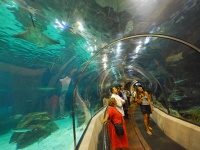
Featuring thousands of brightly coloured and exotic fish, the Barcelona Aquarium is a must for children of all ages. With 35 different tanks holding creatures from different oceans, the aquarium is the largest of its kind in Europe and features species such as giltheads, moray eels, sunfish, rays, sand tiger sharks, and sandbar sharks. The oceanarium is the largest Mediterranean-themed aquarium in the world and the showpiece of the Barcelona Aquarium, with a transparent tunnel winding through it that gives visitors the exhilarating feeling of walking underwater. The whole aquarium houses about 11,000 organisms from 450 different species. The best time to visit is during feeding times: scuba divers feed the sharks on Monday, Wednesday, and Friday between 12pm and 1pm; the entertaining penguins are fed twice daily on weekdays at about 1pm and 5pm, and on weekends at about 1.30pm and 5pm; and the rays are fed between 1.30pm and 2pm every weekday. The aquarium offers scuba diving and cage diving activities for an extra cost. A fun outing for the whole family, the Barcelona Aquarium provides a welcome break from traditional sightseeing in the city.
Address : Moll dEspanya del Port Vell
Website : www.aquariumbcn.com
Telephone : +34 93 221 7474
Opening times : Open Monday to Friday from 9.30am to 9pm; Weekends and public holidays from 9.30am to 9.30pm; in June and September until 9.30pm, and in July and August until 11pm.
Admission : €21 (adults); €16 (children aged 5 - 10); €8 (children aged 3 - 4). Concessions available.
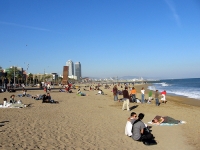
Barcelona's coastline offers a string of attractive beaches, the ideal diversion after excessive sightseeing and shopping. Visit the popular Barceloneta Beach, only ten minutes from the city centre, where there is a selection of beach bars. Cool down with a refreshing swim and marvel at the bizarre architecture of Homenatge a la Barceloneta by Rebecca Horn. Windsurfing and kite surfing are popular activities on this always bustling beach. The end of Barceloneta and the beginning of Icaria Beach is marked by Frank Gehry's El Peix. Marbella Beach is unofficially Barcelona's nudist beach, but although nudity is tolerated, many people choose to keep their clothes on. For a peaceful beach near the city centre look no further than Caldetes, which is invariably almost empty. Although Barceloneta is the most entertaining, the best beaches are further out of the city: St Pol de Mar is an hour-long train ride from the city centre but it is arguably Barcelona's most scenic beach, backed by picturesque hills and with a lovely little cove that has become a nudist zone.
Transport : A twenty minute walk from La Ramblas or Barceloneta metro station, line 4
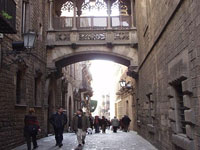
Known as the Gothic Quarter, the Barri Gòtic is Barcelona's oldest district. A former fortified Roman settlement, the maze of atmospheric narrow streets house spectacular Gothic buildings and cathedrals, marking the city's heyday during the 14th and 15th centuries. There are many significant sights, the most illustrious being the immense Gothic Cathedral La Seu, with its breathtaking façade and serene cloister. With an assortment of shops and delightful sidewalk cafés, the Barri Gòtic is a worthwhile day out. To view the remains of this ancient Roman city, once known as Barcino, visit the Museu d'Història de la Ciutat in the Palau Real, where Roman streets are still visible in the extensive cellar. There has been some controversy over the authenticity of the Gothic Quarter, as many of the district's most attractive features were actually added, in the Gothic style, in the last century, to promote tourism and restore the appeal of the area. However, it is a delightful district to explore and much of it is, or certainly feels, authentic. Most of the area is closed to regular traffic and largely pedestrianised, which adds to its charm, but taxis and some service vehicles are still allowed to traverse the quarter.
Transport : Lines 1 and 3 to Catalunya metro station
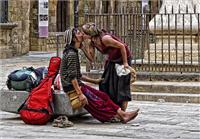
El Raval is a compelling and interesting neighbourhood, with a long and chequered history. It's one of two districts bordering La Rambla, with the other being the established tourist area of Barri Gotic. Located near Barcelona's port, El Raval has always had an exciting, multicultural character, particularly popular with backpackers and revellers keen to check out the city's cutting-edge galleries and clubs. While having undergone a period of development, the area still remains slightly dangerous and tourists should be careful of pickpockets and avoid walking alone at night. El Raval is full of cool bars and funky cafes that beg to be explored, from Bar Marsella with its Art Nouveau interior, to London Bar, a run-down though stately place once frequented by artists like Hemingway, Picasso, and Mirò. Another great sight in El Raval is the Palau Guell, one of Gaudi's lesser-known masterpieces, featuring large parabolic gates decorated with beautiful ironwork.
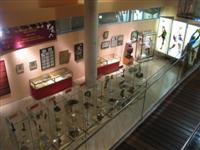
FC Barcelona, one of Europe's most beloved football teams, has an informative museum with displays of photographs, documents, memorabilia, and trophies, covering over a century of club history. Visitors also get the opportunity to explore the famous stadium on the Camp Nou Tour which takes fans to the heart of the club, the changing rooms, tunnel and Nou Camp pitch. With a panoramic view of the stadium from the grandstand, visitors can get a taste of the heady atmosphere of a FC Barcelona match on their home ground. The museum also has an official store where club jerseys, caps and accessories can be purchased. Be sure to check the tour schedule as game days do disrupt the timetable. It is actually best not to make your visit on a game day because some parts of the stadium will be restricted and you may miss out. Exploring the stadium allows fans to make informed decisions about which seats to book if they are attending a game. If you are lucky you may well see some of the FC Barcelona players in the complex. There are discounts for booking online via the official website listed below.
Address : Avenida Arístides Maillol
E-mail : [email protected]
Website : www.fcbarcelona.com
Telephone : +34 902 18 99 00
Transport : Line 3 metro to Maria Cristina
Opening times : Open from Monday to Saturday 10am-6:30pm (till 8pm from 6 April to 4 October). Open on Sundays and public holidays 10am-2:30pm. Tours not available on days of league and Champions league matches, but the museum is still open until 3pm.
Admission : Museum visit and Camp Nou Tour: €26 (adults), €20 (children). Concessions available.
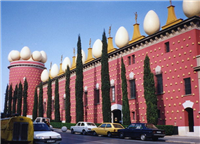
A wonderful daytrip destination from Barcelona, Figueres is a lovely Catalonian town that also happens to be the birthplace of surrealist artist Salvador Dali. The main reason for visiting Figueres is to see the Dali Theatre and Museum (Teatre-Museu Dalí), a suitably bizarre-looking building which is pink, studded, and crowned with enormous eggs. It was not only designed by Dali, but also houses a full spectrum of his imaginative output including paintings, sculptures, 3D collages, mechanical devices, and weird and wonderful installations. The artist is buried in the museum's basement. There is simply no better way to get an appreciation of Dali's genius than by visiting the Teatre-Museu Dalí, and, whether you end up loving or hating his creations, they are sure to keep you thinking and talking for months after your visit. Be warned that many of Dali's works are erotic or grotesque in nature, and may upset younger visitors, making the museum a dubious attraction for families with kids. Feeling like a journey into the artist's mind, this museum is a must for fans.
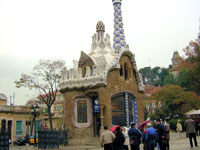
Antonio Gaudi left his mark on Barcelona nowhere more than in the gardens of Guell Park. Sitting on Camel Hill and offering splendid views of the city, it was originally planned to be a garden city suburb. But only two houses were completed before it was turned into a public recreational park. The gardens are festooned with examples of Gaudi's strange and mesmerising work, including flights of stairs, columns, and a plaza decorated with mosaics. Famous features include Gaudi's dragon, and the Sala Hipostila, or Doric Temple, which is a forest of 88 stone columns. Gaudi enjoyed experimenting with natural forms and the park is a fascinating mixture of art and nature. The pink fairytale house standing at the entrance to the park was once home to Gaudi and his niece. However, it's now a museum containing some Gaudi-designed furniture, décor, drawings, and portraits. Guided walking tours of the park are available and usually very informative, but it is enjoyable to stroll around without a guide too. To fully explore the park at your leisure you will need at least half a day.
Website : parkguell.barcelona/en?q=en
Transport : 20 minutes walk from Lesseps Metro stop, or bus 24 from Placa de Catalunya drops you outside the main entrance
Opening times : Open daily from 10am to 7pm (closing times may vary depending on the season)
Admission : Free, but guided tours are available
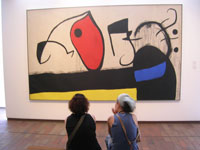
A celebration of the life and work of world-renowned Catalan surrealist sculptor and painter Joan Miró, the Joan Miró Foundation in Barcelona houses the majority of the artist's works, including paintings, drawings, sculptures, and textiles. Distinguished by his use of primary colours, simple lines, and two-dimensional geometric shapes, Miro refused to be categorised into an established art movement and as a result continued to create unparalleled works of art. Another product of original artistic genius from Barcelona, the works of Miró at the Joan Miró Foundation allow visitors to further delve into the unrestrained creative energy of this exceptional city. The building housing the collection was designed by Josep Lluis Sert and is unique and odd, an appropriate shell for the works of Joan Miro. The museum hosts a wide variety of temporary exhibitions by other artists, aiming to promote contemporary art in general, rather than just the work of Miro, and also hosts some workshops and lectures. As an added bonus there are some fantastic views across the city from the museum. Tickets can be booked online via the official website and audio guides can be rented, which are a big help in understanding and interpreting the art.
Address : Parc de Montjuic
Website : www.fundaciomiro-bcn.org
Telephone : +34 934 439 470
Transport : Funiculer from Paral-lel metro station, or Parc Montjuic bus 50, 55 or 193.
Opening times : Open Tuesday to Saturday from 10am to 7pm (October to June) and 10am to 8pm (July to September); open Sundays and holidays from 10am to 2.30pm. Closed on Mondays.
Admission : €11 (adults); audio guides €5. Concessions available.
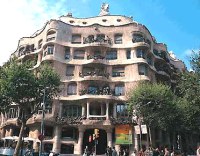
Commonly known as La Pedrera, Casa Mila is an iconic construction by creative genius Antonio Gaudi. It was his last civil work before dedicating all his time to the assembly of La Sagrada Família. The building is a UNESCO World Heritage Site and demonstrates the signature style of Gaudi with elaborate designs, globular shapes, assorted sculptures, colourful tiles, and intricate details. Built between 1906 and 1912, the distinct architecture of La Pedrera and her counterparts was unconventional and unheard of in the popular Spanish architecture of the time. The remarkable building is now a cultural centre that organises a range of activities and hosts exhibitions of various kinds. Areas open to visitors include: the roof, providing lovely views and a close look at the weird and wonderful architectural elements on top of the building; the Espai Gaudi, an attic space dedicated to an exhibition on Gaudi's life and work; the La Pedrera Apartment, an area that recreates the home and lifestyle of a bourgeois Barcelona family in the early 20th century; and the spectacular courtyards and exhibition rooms of the first floor. Guided tours are available in multiple languages but these must be arranged in advance.
Address : 92 Paseo de Gracia.
Website : www.lapedreraeducacio.org
Telephone : +34 932 142 576
Transport : Diagonal metro station
Opening times : Daily 9am to 6.30pm (4 November to 28 February); daily 9am to 8pm (1 March to 3 November).
Admission : €22 (adults), €11 (children aged 7 - 12). Concessions available.
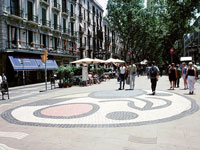
Arguably the most famous street in Europe, the wide tree-lined boulevard known as La Rambla (or Las Ramblas) is a long continuous pedestrian avenue that technically changes names five times as it cuts through Barcelona's Old Town, the Barri Gotic, from the Placa Catalunya to the city's port. It is lined with cafes, restaurants, and shops, usually thronged with leisurely walkers enjoying the sights and sounds. The sprawling marriage of nature and creative architecture and ornamentation that is Gaudi's Guell Park is a must. The pretty square of Placa Reial, enclosed by impressive buildings and promising some fantastic restaurants and nightclubs, is a popular social venue and sometimes hosts concerts and live performances. Also look out for the iconic mosaic by Joan Miro as you walk over it, near the Liceu Theatre. The street is wonderful for shopping and attracts all sorts of buskers and street artists. It is a great area to visit at night, but travellers should note that the southern end of La Rambla becomes somewhat seedy after dark and is an unofficial red light district.
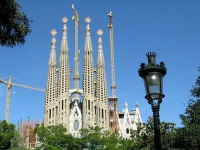
Designed by modernist architect Antoni Gaudi, the bizarre Sagrada Família is one of Catalonia's most intriguing landmarks. Building started in 1882, but it remains unfished and an object of controversy. Gaudi worked on what was considered his masterpiece until his death in 1926. The structure imbues his characteristic Art Nouveau style and creates a unique interpretation of the Gothic architectural tradition. Gaudi had models and plans for the completed church were mostly destroyed during the Spanish Civil War and those leftover have been disputed since. The extraordinary building is a UNESCO World Heritage Site, and is fascinating even to those who don't find it beautiful. The church has been consecrated and is used for religious services. When it is complete it will have 18 towers and is expected to be the tallest church in the world. The anticipated date of completion is 2026 (the centenary of Gaudi's death) but this may prove ambitious. The two completed facades of the church, the Nativity Facade and the Passion Facade, are very different but both incredible, and the roof of the nave is one of the most stunning features. Visiting the church is an absolute must for travellers in Barcelona.
Address : 401 Calle Mallorca.
E-mail : [email protected]
Website : www.sagradafamilia.org
Telephone : +34 932 073 031
Transport : Metro to Sagrada Familia stop
Opening times : Daily from 9am to 6pm. Opening times may change to accommodate events.
Admission : Basic €17, Gaudi House Museum €5.50, and Familia and Towers €32. Concessions available.
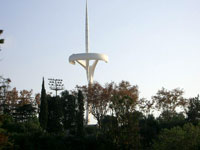
A few of Barcelona's showpieces sit on the hill of Montjuic, overlooking the city centre: the main sites of the 1992 Olympics; the Poble Espanyol; the Joan Miro museum; and the National Art Museum of Catalonia. Montjuic has been the site of several fortifications over the centuries and the most recent of these is the Castle of Montjuic, dating from the 17th century. The castle is now home to the Military Museum as well as the Museum of Comics and Illustration. There are also some leisure attractions and green parks festooned with fountains, themselves popular attractions that entertain on summer evenings with displays of light, colour, and music. Accessible by cable car from Montjuic, the La Barceloneta port district is below the hill. The eastern side is sheer, providing glorious views over the city's harbour. The former fishing village that is now the port is renowned for its seafood restaurants and beach, which is lined with boardwalks and cafes. A grand staircase begins at the foot of Montjuic, at the south end of the Avinguda de la Reina Maria Cristina, and ends at the Palau Nacional, passing a number of historic buildings.
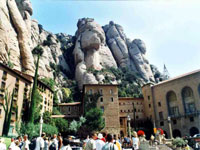
One of the most visited sites in Catalonia is the monastery at Montserrat, 35 miles (56km) northwest of Barcelona. The monastery is surrounded by strange rocky crags and caves, and was founded in 1025 to celebrate local visions of the Virgin Mary. It has become one of the most important pilgrimage sites in Spain, sitting atop a 4,000-foot (1,200m) high mountain and housing about 80 monks. Its main claim to fame is a 12th-century Romanesque wooden sculpture of a black Virgin Mary, known as La Moreneta, which thousands come here to see and touch. There is lots to see at Montserrat, which has a fascinating museum housing masterpieces by artists like Caravaggio and Picasso, as well as exhibitions on the history of the sanctuary and the wider culture, religion, and history of Spain. It has been traditional since the Middle Ages for young people from Barcelona and surrounding regions to make the pilgrimage to Montserrat and watch the sunrise from the heights at least once in their lives. The hike to the monastery is still popular for both pilgrims and travellers. The monastery on its mountain perch is most conveniently reached by cable car.
Website : www.montserratvisita.com/en/index.html
Transport : Train from Espanya station (one hour)
Opening times : Opening times vary according to section and season - check the official website for details.
Admission : Entry to the monastery is free, but the funicular ride to the Holy Grotto is €10 (return).
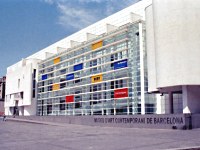
The Barcelona Museum of Contemporary Art is situated in the once-shabby Raval District, just off La Rambla. Over the years its front plaza has become synonymous with international skateboarders, being fondly known as the famous MACBA, drawing skaters and creatives from around the world to unite, compete, and collaborate against the backdrop of this chic white building. Being a work of art in itself, the Museum of Contemporary Art was designed to take advantage of as much natural light as possible and the cool, airy interiors confidently hold the works of modern art luminaries such as Basquiat, Klee, Tàpies, and Barcelò. Kids will enjoy the museum as there is a lot to touch and interact with - this is not your usual uptight gallery space. The museum has also made great use of technology, with an exhibition that allows visitors to download mobile apps which give additional information on each installation, even linking to YouTube clips about the artists. There is free wifi in MACBA and a comfy chill-out zone in which to take advantage of it. A perfect union of two art forms, MACBA and the attendant throng of talented skateboarders are a sight to be experienced.
Address : 1 Plaza dels Angels
Website : www.macba.es
Telephone : +34 934 120 810
Transport : Within walking distance La Ramblas and metro station Universitat or Catalunya
Opening times : 25 September to 24 June: 11am to 7.30pm Monday, Wednesday, Thursday, Friday; 10am to 9pm Saturday; 10am to 3pm Sunday; closed Tuesdays. 25 June to 24 September: 11am to 8pm Monday, Wednesday, Thursday, Friday; 10am to 8pm Saturday; 10am to 3pm Sunday; closed Tuesdays.
Admission : €11 (general); €8.80 (reduced). Children under 14 free.
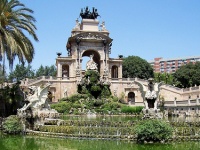
Located in the centre of Barcelona, the Parc de La Ciutadella is a great place to spend a sunny summer's afternoon relaxing under a tree with a book, a picnic, and the family. Originally the site was chosen for a fortress in 1714, but in 1869 it was decided that the area should be a park and the palace was demolished. Featuring a lake where visitors can hire a small rowboat, exploring the park and being out on the water is a fun way to unwind. The paths for walking, jogging, and cycling are wide and well-maintained, while there are some interesting sculptures dotted about the park and some striking buildings. The Cascada is a giant water feature designed by Fontsere with some help from his student Gaudi. The Catalan Parliament building is in the park, as is the Barcelona Zoo and the Castle of Three Dragons, which now houses the Zoological Museum. The Geology Museum, housed in an imposing neoclassical building, can also be found in La Ciutadella. The enormous, red triumphal arch, Baroque in design, marks one entrance to the park.
Address : Avenida del Marques de lArgentera
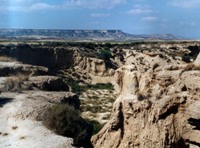
The UNESCO Biosphere Reserve of Parque Natural de Barenas Reales is a semi-desert landscape. The malleable clay, chalk, and sandstone of the landscape has been eroded into surprising and unusual shapes by wind and rain over the millennia. Vegetation of any kind is scarce in the reserve, as is human habitation, and the streams that flow across the barren land are seasonal. The rugged cliffs, hills, and ravines are home to Egyptian Vultures, Golden Eagles, and Peregrine Falcons, with a total of 24 species of birds of prey, as well as many other bird and animal species. Visitors to the park can also see the ruins of Peñaflor Castle, while the nearby towns of Arguedas and Valtierra boast a variety of attractions and historical sites for visitors to enjoy, as well as accommodation. The region is actually comprised of three nature reserves and is an absolute joy for photographers. There are a number of well signposted routes traversing the park which can be followed on foot, by bicycle, on horseback, or by car, and a number of reputable tour companies can arrange tours and activities within the park.
Telephone : +34 948 820 020
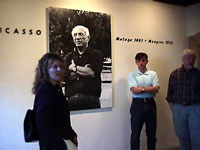
Five palaces dating from the 13th to 15th centuries have been converted into the Picasso Museum, celebrating the country's most famous artist. Sitting on Carrer Montcada, a street known for its elegant medieval structures, it is home to one of the most complete collections of works from his youth and formative years. Pablo Picasso spent his early years in Barcelona (between 1901 and 1906), and the museum is now one of the city's top attractions. It was his wish that his early work would be displayed in Barcelona and the core of the collection was donated by the artist himself. The permanent collection now consists of 4,249 works and the art is complemented interestingly by the old buildings, which showcase the Catalan Gothic style. There are a number of childhood portraits and paintings, as well as engravings, drawings, and art from his Blue and Rose Periods. It is important for visitors to understand that this museum does not house Picasso's most famous and recognisable pieces, but is dedicated instead to an exploration of the artist's formative years and development. Audio guides are available. The queues can get really long at the museum and it is best to arrive early or book in advance online.
Address : 15-23 Montcada Street
Website : www.museupicasso.bcn.es
Telephone : +34 932 563 000
Transport : Metro to Jaume l, Liceu or Arc de Triomf stations; bus 17, 40 or 45 to Via Laietana or Jaume I bus stops, bus 39 or 51 to Passeig Picasso stop
Opening times : Open Tuesday to Sunday from 10am to 8pm.
Admission : €12 (adults). Concessions available.
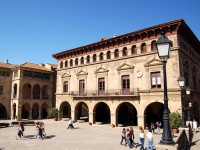
The mock village of Poble Espanyol is an outdoor open-air architectural museum featuring workshops where visitors can see different types of craftwork taking place. The village is made up of 117 buildings, streets, and squares which have been reproduced to scale giving the true feel of a Spanish village. The village was built in 1929 for the Barcelona International Exhibition and some of the replica buildings have now outlived the originals, which were found in villages across Spain. The village is a great attraction for those travelling with children, with fun activities like treasure hunts to take part in, and some fantastic shopping opportunities. More than 30 craft workshops demonstrate the traditional secrets of the different art forms, producing high-quality crafts. The workshops produce handmade dolls and puppets, embroidery, ceramics, glassware, jewellery, baskets, textiles, leather work, soap, and more. Various art exhibitions and studios can be found in the village, including a sculpture garden. The village also showcases Spanish gastronomy, with a wide variety of restaurants dedicated to different Spanish culinary traditions, and plenty of events and activities organised for foodies. A deservedly popular tourist attraction, Poble Espanyol is a wonderful cultural experience.
Website : www.poble-espanyol.com
Telephone : +34 93 508 6300
Opening times : Monday 9am to 8pm; Tuesday, Wednesday, Thursday and Sunday 9am to midnight; Friday 9am to 3am; Saturday 9am to 4am.
Admission : €12.60 (adults); €6,30 (children aged 4 - 12). Concessions available.
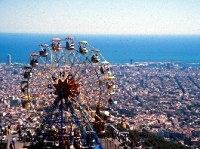
Barcelona's second landmark hill is Tibidabo, about four miles (6km) northwest of the city in a wooded range that forms a backdrop to the urban landscape. Tibidabo can be reached by funicular - the journey up is half the fun, with spectacular views - and is particularly popular on weekends with locals because it is home to the Parc d'Atraccions, an amusement park with some thrill rides and a renowned house of horrors. Tibidabo also features the soaring Torre de Collserola telecommunications tower, which offers visitors the chance to ride in a glass lift to an observation platform 377 feet (115m) high to enjoy a truly phenomenal view. A large church named the Temple del Sagrat Cor is surmounted by a giant Christ statue, offerinig a lift to a rooftop viewing platform, while the Carretera des Aigues trail is perfect for keen hikers who want to climb the hill at their own pace. It is an easy walk, which only takes about an hour, starting from the base of the funicular and ending at the church. There are a number of restaurants to enjoy on the hill.
Address : Plaça Tibidabo, 3-4, Barcelona, Spain.
Website : www.tibidabo.es
Telephone : +34 932 117 942
Opening times : 11am to 11pm, Monday to Sunday.
Admission : €
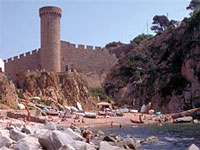
The medieval fishing village of Tossa de Mar, 56 miles (90km) north of Barcelona, is the most attractive town on the Costa Brava, offering lovely sandy beaches and a lively atmosphere. Visitors are drawn to its 12th century walled town, Vila Vella, the ancient walls, battlements, and towers enclosing a quaint historical labyrinth. There is also the ancient Castillo de Tossa de Mar, a one-time Roman fortress dominating the bay, which visitors are free to explore. There are four beaches within the town itself and numerous others flanking Tossa on either side. It is easy to get around town on foot, but there is a blue and white tourist train that offers tours of the town, and a green train that takes visitors up to the fort. It is possible to walk up but don't try driving yourself up as the roads get very narrow and there is no parking at the top. There are, however, wonderful views and photo opportunities, and a visit to the fort is worthwhile for this alone. There are diving shops and centres in town to provide equipment and advice for scuba expeditions, and glass-bottomed boat tours and snorkelling are also popular.
Website : www.infotossa.com

Travel Guide powered by Word Travels, copyright © 2023 Globe Media Ltd. By its very nature information in this travel guide is subject to change at short notice and travellers are urged to verify information on which they're relying with the relevant authorities. Neither Globe Media Ltd nor Travel Vogue can accept any responsibility for any loss or inconvenience to any person as a result of information contained above.